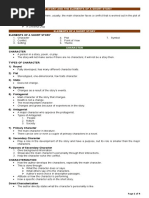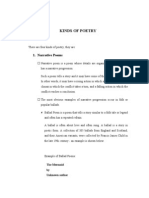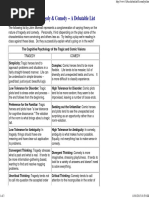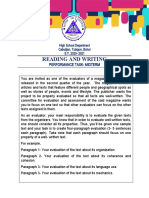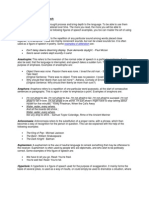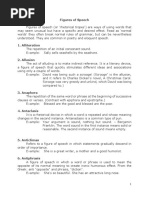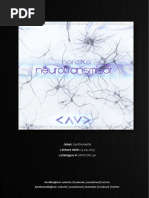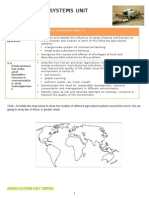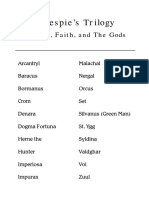Essay Writing
Essay Writing
Uploaded by
anjumdkCopyright:
Available Formats
Essay Writing
Essay Writing
Uploaded by
anjumdkOriginal Description:
Copyright
Available Formats
Share this document
Did you find this document useful?
Is this content inappropriate?
Copyright:
Available Formats
Essay Writing
Essay Writing
Uploaded by
anjumdkCopyright:
Available Formats
Essay
An essay is generally a short piece of writing outlining the writer’s perspective or story. It is often
considered synonymous with a story or a paper or an article. Essays can be both formal as well as informal.
Formal essays are generally academic in nature and tackle serious topics. We will be focusing on informal
essays which are more personal and often have humorous elements.
Types of Essays
The type of an essay will depend on what the writer wants to convey to his reader. There are broadly four
types of essays. Let us see.
Narrative Essays: This is when the writer is narrating an incident or story through the essay. So these are in
the first person. The aim when writing narrative essays is to involve the reader in them as if they were right
there when it was happening. SO make them as vivid and real as possible. One way to make this possible is
to follow the principle of ‘show, don’t tell’. So you must involve the reader in the story.
Descriptive Essays: Here the writer will describe a place, an object, an event or maybe even a memory. But
it is not just plainly describing things. The writer must paint a picture through his words. One clever way to
do that is to evoke the senses of the reader. Do not only rely on sight but also involve the other senses of
smell, touch, sound etc. A descriptive essay when done well will make the reader feel the emotions the
writer was feeling at the moment.
Expository Essays: In such an essay a writer presents a balanced study of a topic. To write such an essay,
the writer must have real and extensive knowledge about the subject. There is no scope for the writer’s
feelings or emotions in an expository essay. It is completely based on facts, statistics, examples etc. There
are sub-types here like contrast essays, cause and effect essays etc.
Persuasive Essays: Here the purpose of the essay is to get the reader to your side of the argument. A
persuasive essay is not just a presentation of facts but an attempt to convince the reader of the writer’s point
of view. Both sides of the argument have to be presented in these essays. But the ultimate aim is to persuade
the readers that the writer’s argument carries more weight.
Format of an Essay
Now there is no rigid format of an essay. It is a creative process so it should not be confined within
boundaries. However, there is a basic structure that is generally followed while writing essays. So let us take
a look at the general structure of an essay.
Introduction
This is the first paragraph of your essay. This is where the writer introduces his topic for the very first time.
You can give a very brief synopsis of your essay in the introductory paragraph. Generally, it is not very
long, about 4-6 lines.
There is plenty of scopes to get creative in the introduction of essays. This will ensure that you hook the
reader, i.e. draw and keep his attention. So to do so you can start with a quote or a proverb. Sometimes you
can even start with a definition. Another interesting strategy to engage with your reader is to start with a
question.
Prof. M. Shafique Anjum Dk IDEAL ENGLISH ACADEMY Page 1
Govt. Post Graduate College, Gojra SAMNABAD, GOJRA
Body
This is the main crux of your essays. The body is the meat of your essay sandwiched between the
introduction and the conclusion. So the most vital and important content of the essay will be here. This need
not be confined to one paragraph. It can extend to two or more paragraphs according to the content.
Usually, we have a lot of information to provide in the body. And the mistakes writers generally make is to
go about it in a haphazard manner which leaves the reader confused. So it is important to organize your
thoughts and content. Write the information in a systematic flow so that the reader can comprehend. So, for
example, you were narrating an incident. The best manner to do this would be to go in a chronological order.
Conclusion
This is the last paragraph of the essay. Sometimes a conclusion will just mirror the introductory paragraph
but make sure the words and syntax are different. A conclusion is also a great place to sum up a story or an
argument. You can round up your essay by providing some moral or wrapping up a story. Make sure you
complete your essays with the conclusion, leave no hanging threads.
Tips for Essay Writing
Give your essays an interesting and appropriate title. It will help draw the attention of the reader and pique
their curiosity
Keep it between 300-500 words. This is the ideal length, you can take creative license to increase or
decrease it
Keep your language simple and crisp. Unnecessary complicated and difficult words break the flow of the
sentence.
Do not make grammar mistakes, use correct punctuation and spellings. If this is not done it will distract the
reader from the content
Before beginning the essay organize your thought and plot a rough draft. This way you can ensure the story
will flow and not be an unorganized mess.
Prof. M. Shafique Anjum Dk IDEAL ENGLISH ACADEMY Page 2
Govt. Post Graduate College, Gojra SAMNABAD, GOJRA
Brief Overview of the 10 Essay Writing Steps
Below are brief summaries of each of the ten steps to writing an essay. Select the links for more info on any
particular step, or use the blue navigation bar on the left to proceed through the writing steps. How To Write
an Essay can be viewed sequentially, as if going through ten sequential steps in an essay writing process, or
can be explored by individual topic.
1. Research: Begin the essay writing process by researching your topic, making yourself an expert. Utilize
the internet, the academic databases, and the library. Take notes and immerse yourself in the words of great
thinkers.
2. Analysis: Now that you have a good knowledge base, start analyzing the arguments of the essays you're
reading. Clearly define the claims, write out the reasons, the evidence. Look for weaknesses of logic, and
also strengths. Learning how to write an essay begins by learning how to analyze essays written by others.
3. Brainstorming: Your essay will require insight of your own, genuine essay-writing brilliance. Ask
yourself a dozen questions and answer them. Meditate with a pen in your hand. Take walks and think and
think until you come up with original insights to write about.
4. Thesis: Pick your best idea and pin it down in a clear assertion that you can write your entire essay
around. Your thesis is your main point, summed up in a concise sentence that lets the reader know where
you're going, and why. It's practically impossible to write a good essay without a clear thesis.
5. Outline: Sketch out your essay before straightway writing it out. Use one-line sentences to describe
paragraphs, and bullet points to describe what each paragraph will contain. Play with the essay's order. Map
out the structure of your argument, and make sure each paragraph is unified.
6. Introduction: Now sit down and write the essay. The introduction should grab the reader's attention, set
up the issue, and lead in to your thesis. Your intro is merely a buildup of the issue, a stage of bringing your
reader into the essay's argument.
(Note: The title and first paragraph are probably the most important elements in your essay. This is an
essay-writing point that doesn't always sink in within the context of the classroom. In the first paragraph you
either hook the reader's interest or lose it. Of course your teacher, who's getting paid to teach you how to
write an essay, will read the essay you've written regardless, but in the real world, readers make up their
minds about whether or not to read your essay by glancing at the title alone.)
7. Paragraphs: Each individual paragraph should be focused on a single idea that supports your thesis.
Begin paragraphs with topic sentences, support assertions with evidence, and expound your ideas in the
clearest, most sensible way you can. Speak to your reader as if he or she were sitting in front of you. In other
words, instead of writing the essay, try talking the essay.
Prof. M. Shafique Anjum Dk IDEAL ENGLISH ACADEMY Page 3
Govt. Post Graduate College, Gojra SAMNABAD, GOJRA
8. Conclusion: Gracefully exit your essay by making a quick wrap-up sentence, and then end on some
memorable thought, perhaps a quotation, or an interesting twist of logic, or some call to action. Is there
something you want the reader to walk away and do? Let him or her know exactly what.
9. MLA Style: Format your essay according to the correct guidelines for citation. All borrowed ideas and
quotations should be correctly cited in the body of your text, followed up with a Works Cited (references)
page listing the details of your sources.
10. Language: You're not done writing your essay until you've polished your language by correcting the
grammar, making sentences flow, incoporating rhythm, emphasis, adjusting the formality, giving it a level-
headed tone, and making other intuitive edits. Proofread until it reads just how you want it to sound. Writing
an essay can be tedious, but you don't want to bungle the hours of conceptual work you've put into writing
your essay by leaving a few slippy misppallings and pourly wordedd phrazies..
Topics
1. Role of women/ women rights/ women education
2. Media, both print and electronic/ social media
3. Mobile phone
4. Water crisis/ energy crisis/ load shedding
5. Corruption
6. Co-education
7. National unity
8. Pollution
9. Islam is a religion of peace
10. Overpopulation/ population explosion
11. Democracy/ good governance
12. Terrorism/ extremism
13. Elections in Pakistan/ local bodies election
14. Value of science
15. Social evils in Pakistan
16. CPEC
17. Poverty
18. Drug addiction
19. Importance of Co-curricular activities
20. Unemployment
Prof. M. Shafique Anjum Dk IDEAL ENGLISH ACADEMY Page 4
Govt. Post Graduate College, Gojra SAMNABAD, GOJRA
You might also like
- Short Story Analysis AssignmentDocument2 pagesShort Story Analysis Assignmentapi-203814269100% (2)
- Example Literary ParagraphDocument2 pagesExample Literary Paragraphapi-237159930100% (1)
- Spread Footing Design: U D A P QDocument18 pagesSpread Footing Design: U D A P QOnline Review Specialists100% (1)
- Difference Between Formal and Informal WritingDocument3 pagesDifference Between Formal and Informal WritingReniel Eda100% (1)
- Formal and Informal LanguageDocument5 pagesFormal and Informal LanguageNguyen Thi Ngoc Hanh100% (1)
- Blake Divine ImageDocument2 pagesBlake Divine ImageanjumdkNo ratings yet
- Car Sticker Form & GuidelinesDocument2 pagesCar Sticker Form & GuidelinesCrisline Pilapil100% (1)
- Primary Source: Excerpts From The Official Report of Governor Izquierdo On The Cavite Mutiny of 1872Document4 pagesPrimary Source: Excerpts From The Official Report of Governor Izquierdo On The Cavite Mutiny of 1872Earlyn Joy Sevilla Lugo100% (5)
- AZ Secy/State App For Attorneys' Fees vs. AZGOPDocument11 pagesAZ Secy/State App For Attorneys' Fees vs. AZGOPpaul weichNo ratings yet
- Types of Essays PDFDocument6 pagesTypes of Essays PDFOmar Jean Piaget BorperNo ratings yet
- The Type of Essay Will Depend On What The Writer Wants To Convey To His Reader. There Are Broadly Four Types of Essays. Let Us SeeDocument4 pagesThe Type of Essay Will Depend On What The Writer Wants To Convey To His Reader. There Are Broadly Four Types of Essays. Let Us SeeFarhiya MohamedNo ratings yet
- L6 - Figures of Speech and Its ExamplesDocument34 pagesL6 - Figures of Speech and Its ExamplesJames Alexander DezaNo ratings yet
- Allusions: Short Examples of AllusionDocument15 pagesAllusions: Short Examples of AllusionJohanna Dapuyen MacaybaNo ratings yet
- Coherence & Cohesion JAN 6Document66 pagesCoherence & Cohesion JAN 6AntonetteEspinaNo ratings yet
- Narrative and Descriptive EssaysDocument18 pagesNarrative and Descriptive EssaysAna Lucia Chaves Barquero100% (2)
- Pre Writing TechniquesDocument7 pagesPre Writing TechniquesShehzad KhanNo ratings yet
- What Is Expository WritingDocument7 pagesWhat Is Expository WritingStudent ResearchNo ratings yet
- Basic Features and Elements of An EssayDocument5 pagesBasic Features and Elements of An EssayLiezl Sabado80% (5)
- Elements of A Short StoryDocument4 pagesElements of A Short StoryA C100% (1)
- Expository WritingDocument110 pagesExpository WritingyenNo ratings yet
- Figure of Speech QuestionsDocument7 pagesFigure of Speech QuestionsMarjBuccatNo ratings yet
- East Asian LiteratureDocument33 pagesEast Asian LiteratureEscaran NicoleNo ratings yet
- What Is The Truth? Said Jesting Pilate, and Would Not Stay For An Answer.Document2 pagesWhat Is The Truth? Said Jesting Pilate, and Would Not Stay For An Answer.Zunera Ashraf100% (1)
- Types of EssaysDocument6 pagesTypes of Essaysslsschool100% (8)
- Precis WritingDocument37 pagesPrecis WritingLetlie SemblanteNo ratings yet
- ELEMENTS OF POE-WPS Office1Document24 pagesELEMENTS OF POE-WPS Office1ROBLOX TVNo ratings yet
- Literary FormsDocument9 pagesLiterary FormsChristine Joyce Gregorio100% (1)
- Different Types of EssayDocument4 pagesDifferent Types of EssayBambi Pajaro75% (4)
- Subject Verb AgreementDocument7 pagesSubject Verb AgreementBily ManNo ratings yet
- 7) Fact, Inference, JudgementDocument18 pages7) Fact, Inference, JudgementRudra Pratap Singh100% (1)
- Types of Literature: Fiction and Non-FictionDocument6 pagesTypes of Literature: Fiction and Non-FictionCoolveticaNo ratings yet
- Techniques in SummarizingDocument17 pagesTechniques in SummarizingJessa Marie Sabuga-aNo ratings yet
- Methods of Development With Paragraphs and ExercisesDocument8 pagesMethods of Development With Paragraphs and ExercisesMuhammad Miftakhul UlumNo ratings yet
- English-American Writers and Their WorksDocument36 pagesEnglish-American Writers and Their WorksAR DÇNo ratings yet
- PDF - What Is A Descriptive EssayDocument3 pagesPDF - What Is A Descriptive EssayAndi Syaiful RifliNo ratings yet
- Composition WritingDocument4 pagesComposition Writingewais22No ratings yet
- 11 Writing Your First DraftDocument20 pages11 Writing Your First DraftAL ' ARISNo ratings yet
- Kinds of PoetryDocument6 pagesKinds of PoetryZula IkhaNo ratings yet
- Definition and Parts of A ParagraphDocument6 pagesDefinition and Parts of A ParagraphFrancis B. Tatel100% (1)
- Coordinate and Non Coordinate AdjectivesDocument19 pagesCoordinate and Non Coordinate AdjectivesWincy Ayunon100% (1)
- Lesson II PhrasesDocument26 pagesLesson II PhrasesRuth Magoods100% (1)
- Transitional WordsDocument38 pagesTransitional Wordsjho_olis67% (3)
- Understanding ProseDocument92 pagesUnderstanding ProseRahmi Munfangati100% (2)
- PhonologyDocument6 pagesPhonologyIcka VeronikaNo ratings yet
- Comedy Tragedy CharacteristicsDocument3 pagesComedy Tragedy CharacteristicsAbhimanyu JhaNo ratings yet
- Essay WritingDocument4 pagesEssay WritingIvan Stepanov100% (1)
- Figures of Speech LessonDocument2 pagesFigures of Speech LessonMomi BearFruits100% (1)
- Reading and Writing: Performance Task-MidtermDocument2 pagesReading and Writing: Performance Task-MidtermChristian BlantucasNo ratings yet
- Sentence and Its Types-1Document22 pagesSentence and Its Types-1Z Noor0% (1)
- 2022 First Term Literature Note Grade 7Document39 pages2022 First Term Literature Note Grade 7muna.nwachukwuNo ratings yet
- Definition of Foot: Meter PoemDocument8 pagesDefinition of Foot: Meter PoembelbachirNo ratings yet
- 14 Punctuation Marks in English GrammarDocument5 pages14 Punctuation Marks in English GrammarMarilyn PadojinogNo ratings yet
- William Shakespeare: Presentation Topic: Sonnet No 1 "From The Fairest Creatures We Desire Increase"Document15 pagesWilliam Shakespeare: Presentation Topic: Sonnet No 1 "From The Fairest Creatures We Desire Increase"Hussain AliNo ratings yet
- Summary Writing 5S PPTDocument21 pagesSummary Writing 5S PPTAndrea Beharry100% (1)
- Elliptical SentencesDocument6 pagesElliptical SentencesAlfiannorNo ratings yet
- Marxist Literary ApproachDocument18 pagesMarxist Literary Approachgiancarloopena2No ratings yet
- Examples of Figures of SpeechDocument3 pagesExamples of Figures of SpeechArneil Enario100% (1)
- Class 10 and 9 Writing Directions-1Document6 pagesClass 10 and 9 Writing Directions-1Do Something GoodNo ratings yet
- Expository WritingDocument23 pagesExpository WritingKenny EclingNo ratings yet
- Figure of SpeechDocument5 pagesFigure of SpeechChing EvangelioNo ratings yet
- Types of EssaysDocument5 pagesTypes of Essaysbhoomikalohana70No ratings yet
- Descriptive Essays: Here The Writer Will Describe A Place, An Object, An Event or Maybe Even A MemoryDocument2 pagesDescriptive Essays: Here The Writer Will Describe A Place, An Object, An Event or Maybe Even A MemoryIrina JiroveanuNo ratings yet
- Essay WritingDocument2 pagesEssay Writingzeeshanshah5382No ratings yet
- BCP - BCH Essay Writing PDFDocument4 pagesBCP - BCH Essay Writing PDFPALLAVI pallavi2No ratings yet
- The Type of Essay Will Depend On What The Writer Wants To Convey To His Reader. There Are Broadly Four Types of Essays. Let Us SeeDocument5 pagesThe Type of Essay Will Depend On What The Writer Wants To Convey To His Reader. There Are Broadly Four Types of Essays. Let Us SeeFarhiya MohamedNo ratings yet
- Elizabethan Poetry: Prof. M. Shafique Anjum DK Govt. Post Graduate College, GojraDocument3 pagesElizabethan Poetry: Prof. M. Shafique Anjum DK Govt. Post Graduate College, GojraanjumdkNo ratings yet
- Analysis of Complex Sentences Analysis of Simple SentencesDocument11 pagesAnalysis of Complex Sentences Analysis of Simple SentencesanjumdkNo ratings yet
- Brief Biography of Bertolt Brecht: Historical Context of The Life of GalileoDocument13 pagesBrief Biography of Bertolt Brecht: Historical Context of The Life of GalileoanjumdkNo ratings yet
- Departure and ArrivalDocument1 pageDeparture and Arrivalanjumdk100% (1)
- Henrik Ibsen Early Life: Prof. M. Shafique Anjum DK Ideal English Academy Govt. Post Graduate College, Samnabad, GojraDocument4 pagesHenrik Ibsen Early Life: Prof. M. Shafique Anjum DK Ideal English Academy Govt. Post Graduate College, Samnabad, Gojraanjumdk100% (1)
- Homer: Prof. M. Shafique Anjum DKDocument8 pagesHomer: Prof. M. Shafique Anjum DKanjumdkNo ratings yet
- Racism: "Don't Sit There, Honey, You Never Know What They Have". Black People Take Menial Jobs and Have To BeDocument3 pagesRacism: "Don't Sit There, Honey, You Never Know What They Have". Black People Take Menial Jobs and Have To BeanjumdkNo ratings yet
- Intro To HardyDocument9 pagesIntro To HardyanjumdkNo ratings yet
- DR FaustusDocument4 pagesDR FaustusanjumdkNo ratings yet
- Major and Minor ThemesDocument2 pagesMajor and Minor ThemesanjumdkNo ratings yet
- Muslim AdventDocument2 pagesMuslim AdventanjumdkNo ratings yet
- Introduction: Romance Versus NovelDocument2 pagesIntroduction: Romance Versus NovelanjumdkNo ratings yet
- Code HeroDocument12 pagesCode HeroanjumdkNo ratings yet
- Chaucer HumourDocument1 pageChaucer HumouranjumdkNo ratings yet
- Chimney SweeperDocument2 pagesChimney Sweeperanjumdk50% (2)
- Russel Essay Eastern and Western Ideals of HappinesDocument12 pagesRussel Essay Eastern and Western Ideals of Happinesanjumdk0% (1)
- LondonDocument3 pagesLondonanjumdkNo ratings yet
- Dejection An OdeDocument6 pagesDejection An Odeanjumdk75% (4)
- First Military Era (1958-1971)Document4 pagesFirst Military Era (1958-1971)anjumdk100% (1)
- Essay On EnvironmentDocument2 pagesEssay On EnvironmentanjumdkNo ratings yet
- MCAT Pakistan: Prof. M. Shafique Anjum DK Ideal English Academy Govt. Post Graduate College, Gojra Samnabad, GojraDocument1 pageMCAT Pakistan: Prof. M. Shafique Anjum DK Ideal English Academy Govt. Post Graduate College, Gojra Samnabad, Gojraanjumdk100% (1)
- Feminism: A Political, Cultural, and Economic Movement That Aims at Establishing GreaterDocument1 pageFeminism: A Political, Cultural, and Economic Movement That Aims at Establishing GreateranjumdkNo ratings yet
- Once Upon A TimeDocument4 pagesOnce Upon A TimeanjumdkNo ratings yet
- Q. Where Is Harlem and What Was Notable About It During The Time Period of The Novel?Document3 pagesQ. Where Is Harlem and What Was Notable About It During The Time Period of The Novel?anjumdkNo ratings yet
- Analysis of The FoxDocument2 pagesAnalysis of The FoxanjumdkNo ratings yet
- Heaney's Concept of Redressing Effects of Poetry: Prof. M. Shafique Anjum DK Govt. Post Graduate College, GojraDocument4 pagesHeaney's Concept of Redressing Effects of Poetry: Prof. M. Shafique Anjum DK Govt. Post Graduate College, GojraanjumdkNo ratings yet
- 00 - Nordika - Neurotransmisor - MetadataDocument3 pages00 - Nordika - Neurotransmisor - Metadatathenewmanchester92No ratings yet
- Conformation ProcessesDocument46 pagesConformation ProcessessowjanyaNo ratings yet
- Operant Conditioning in The Classroom 2Document4 pagesOperant Conditioning in The Classroom 2KIM GED ALCOBERESNo ratings yet
- Feminist Research MethodologyDocument17 pagesFeminist Research Methodologyrupal arora100% (1)
- The Wanderer by Craig Williamson (Transl.)Document6 pagesThe Wanderer by Craig Williamson (Transl.)Cristina de la CruzNo ratings yet
- Junglee Child - Visual Pitch DeckDocument15 pagesJunglee Child - Visual Pitch Decksarah stuntNo ratings yet
- Digital VVVF Synchronized Door Operator Installation InstructionDocument26 pagesDigital VVVF Synchronized Door Operator Installation InstructionYing Dang100% (1)
- EDPA CvrulesDocument70 pagesEDPA Cvrulesfile_transfersNo ratings yet
- 1691 - Phrasal Verbs Test 08 PDFDocument4 pages1691 - Phrasal Verbs Test 08 PDFPhuong Nghi NguyenNo ratings yet
- Long Quiz 3iDocument2 pagesLong Quiz 3iNica Joyce AquinoNo ratings yet
- W12 OMS311 SyllabusDocument15 pagesW12 OMS311 SyllabusYoung H. ChoNo ratings yet
- CSC Q3 0202 - PS - Community Dynamics and Process ElementsDocument37 pagesCSC Q3 0202 - PS - Community Dynamics and Process ElementsNylana Cañedo del CastilloNo ratings yet
- Igcse Agricultural Systems 2015Document37 pagesIgcse Agricultural Systems 2015api-261914272100% (1)
- Qayamat Ke Din Ki NashaniaDocument59 pagesQayamat Ke Din Ki NashaniaIrfan Ahmed KhanNo ratings yet
- The Impact of Cell Phone, Laptop Computer, and Microwave Oven Usage On Male FertilityDocument17 pagesThe Impact of Cell Phone, Laptop Computer, and Microwave Oven Usage On Male FertilitymaxsmaxNo ratings yet
- Science Lesson Plan FinalDocument4 pagesScience Lesson Plan Finalty70001No ratings yet
- Table of Specification (TOS) : - A Teacher's Blueprint in Constructing A Test For Classroom UseDocument15 pagesTable of Specification (TOS) : - A Teacher's Blueprint in Constructing A Test For Classroom UseJuan Miguel100% (2)
- 117AL01Document3 pages117AL01Danidhariya NiravNo ratings yet
- GTU AERO445 Turbomachinery WEEK3 NotesDocument25 pagesGTU AERO445 Turbomachinery WEEK3 NotesVainamoinen MiddlefingerNo ratings yet
- Microwave Oven: User ManualDocument124 pagesMicrowave Oven: User ManualMarkNo ratings yet
- Gillespies Trilogy DeitiesDocument12 pagesGillespies Trilogy DeitiesBloody SundayNo ratings yet
- NWC Parent Module 4 - RevisedDocument2 pagesNWC Parent Module 4 - RevisedLeiron Andree ZapicoNo ratings yet
- The Aesthetic Validity of MarriageDocument17 pagesThe Aesthetic Validity of MarriageKozure ŌkamiNo ratings yet
- Jazan: CausesDocument1 pageJazan: CausesMuhammad SalmanNo ratings yet
- Running Bill Formate For DevkamiyatiDocument15 pagesRunning Bill Formate For DevkamiyatiOm Chauhan100% (1)
- Check List - How Assignment A Will Be AssessedDocument3 pagesCheck List - How Assignment A Will Be AssessedKatrina WongNo ratings yet


















